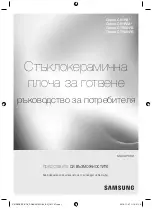
EN
Failure Display and Inspection
If an abnormality comes up, the induction hob will enter the protective state
automatically and display corresponding protective codes. These are the most common
failures:
Error
Message
Possible causes
What to do
No cookware or cookware not suitable.
Replace the cookware.
ER03
Water or cookware on the glass over the
control area.
Clean the control area.
F1E
Connection between the display board
and the left mainboard fails (the cooking
zone which indicator shows “E”).
1.Connection cable not correctly
plugged or defective.
2.Replace the mainboard.
F3E
Coil temperature sensor failure. (in the
cooking zone which indicator shows
“E”).
Replace the coil sensor.
F4E
Mainboard temperature sensor failure.
(in the cooking zone which indicator
shows “E”).
Replace the mainboard.
E1E
Temperature measured by the sensor of
the ceramic glass is too high.
Please restart after the hob has been
cooled down.
E2 E
Temperature sensor of the IGBT is too
high.
Please restart after the hob has been
cooled down.
E3 E
Abnormal supply voltage (too high).
Please inspect whether power supply
is normal. Switch on after the power
supply is normal.
E4 E
Abnormal supply voltage (too low).
Please inspect whether power supply
is normal. Switch on after the power
supply is normal.
E5 E
Temperature sensor failure (in the
cooking zone which indicator shows E”).
Connection cable not correctly
plugged or the assembly is defective.
Please do not disassemble the unit by yourself to avoid any dangers and damages to
the induction hob.
Choosing the right cookware (F5)
-
Preferably use cookware indicated as being suitable for induction cooking.
-
A magnet-attracting cookware may be suitable for induction cooking.
-
Stainless steel cookware with multi-layer or ferritic stainless-steel bases if the
base indicates: for induction cooking.
-
If cast iron cookware is used, it should preferably have an enamel bottom to avoid
scratching the ceramic hob surface.
-
The following types of cookware are not suitable: glass, ceramic, earthenware,
aluminium, copper or non-magnetic (austenitic) stainless steel.
-
Flat and thick-bottomed cookware.
-
A cookware with the same diameter as the cooking zone ensures the maximum
power is used.
-
A smaller cookware reduces the power but will not lead to energy loss. In any case,
















































